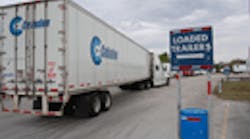INDIANAPOLIS. Two overarching themes will dominate trucking’s near-term future, according to experts and fleet executives gathered here for FTR Associates 2010 Transportation Conference. The first is that the truck freight volumes will continue to increase, which, when placed alongside a continued dearth of capacity, means rates will also rise.
The second theme, however, is starker, explained Noël Perry, principal of research firm Transport Fundamentals and senior consultant with FTR: the trucking business environment will be much more difficult than ever experienced in the past.
“We are in a happy time for trucking and it will probably get better – even though monthly truck freight volumes continue to swing, showing the effect of the general economic ‘pause’ we’re [the U.S.] experiencing,” Perry said. “However, we are still way below the previous freight peak [of 2006] and it will take us until at least 2013 to get back to it.”
Still, with active truck capacity very tight – running about 94%, according to FTR’s data – truckers should be in a position to profit from a projected 4% to 5% growth in freight expected through next year, Perry said.
Scott Arves, president &CEO of truckload carrier Transport America, said most fleets are trying to work their way back to the 9% margins they last experienced in 2006 and won’t add capacity until reaching that target.
FTR’s Perry believes average rate hikes of 10% to 12%, before fuel surcharges, are possible as fleets prepare to deal with other challenges, notably a driver shortage, the costs of regulatory compliance, and the hefty price tag for new equipment.
Keith Klein, executive vp & COO of Transport America, noted that the base price of the Class 8 tractors used in his company’s fleet has increased $25,000 over the last six to seven years – largely due to new emission control systems mandated by EPA.
Finding, hiring and retaining drivers will also be more problematic in the near-term. The Federal Motor Carrier Safety Administration’s (FMCSA) new Comprehensive Safety Analysis 2010 (CSA 2010), due to go into full effect by December, is expected to slice as much as 5% from the available pool of truck drivers, according to Jason Siedel, director of equity research for Dahlman Rose & Co. LLC . That will compound the growing shortage of drivers that’s rearing up on the horizon. (Read more FMCSA news)
FTR’s Perry said projected freight growth combined with the 25% to 35% reduction in trucking capacity during the recession and tighter regulatory requirements imposed by CSA 2010 will create an acute shortage of drivers by 2011 – one expected to grow to about 150,000 annually over the next few years.
“And remember, to actually seat 150,000 drivers, you need to start by processing 1 million applications to get 175,000 to 185,000 qualified people into driver training programs – and you lose some of them along the way,” he explained. “Soon, we’ll be right back where we were in 2004.”
“The convergence of regulations in late 2011 and 2012 – from CSA 2010, new hours of service (HOS) regulations, and driver identification requirements – will put a lot more pressure on the supply of drivers,” added Max Fuller, co-chairman of TL carrier U.S. Xpress Enterprises.
Fleets will also have to shell out more to attract that many people into the driver’s seat, he noted. For example, to just increase his driver corps by 5% today, Fuller said it would require a base pay increase of four to six cents per mile plus a $5,000 sign-on bonus.
Added to the “sticker shock” for new equipment, that creates major long-term capacity issues, he said. “Capacity will be a real problem for the next two to five years as a result,” Fuller stated.



